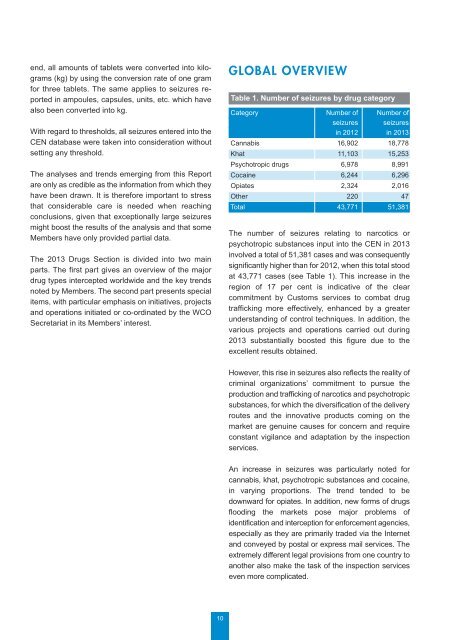You also want an ePaper? Increase the reach of your titles
YUMPU automatically turns print PDFs into web optimized ePapers that Google loves.
end, all amounts of tablets were converted into kilograms<br />
(kg) by using the conversion rate of one gram<br />
for three tablets. The same applies to seizures reported<br />
in ampoules, capsules, units, etc. which have<br />
also been converted into kg.<br />
With regard to thresholds, all seizures entered into the<br />
CEN database were taken into consideration without<br />
setting any threshold.<br />
The analyses and trends emerging from this Report<br />
are only as credible as the information from which they<br />
have been drawn. It is therefore important to stress<br />
that considerable care is needed when reaching<br />
conclusions, given that exceptionally large seizures<br />
might boost the results of the analysis and that some<br />
Members have only provided partial data.<br />
The <strong>2013</strong> Drugs Section is divided into two main<br />
parts. The first part gives an overview of the major<br />
drug types intercepted worldwide and the key trends<br />
noted by Members. The second part presents special<br />
items, with particular emphasis on initiatives, projects<br />
and operations initiated or co-ordinated by the WCO<br />
Secretariat in its Members’ interest.<br />
GLOBAL OVERVIEW<br />
Table 1. Number of seizures by drug category<br />
Category Number of Number of<br />
seizures seizures<br />
in 2012 in <strong>2013</strong><br />
Cannabis 16,902 18,778<br />
Khat 11,103 15,253<br />
Psychotropic drugs 6,978 8,991<br />
Cocaine 6,244 6,296<br />
Opiates 2,324 2,016<br />
Other 220 47<br />
Total 43,771 51,381<br />
The number of seizures relating to narcotics or<br />
psychotropic substances input into the CEN in <strong>2013</strong><br />
involved a total of 51,381 cases and was consequently<br />
significantly higher than for 2012, when this total stood<br />
at 43,771 cases (see Table 1). This increase in the<br />
region of 17 per cent is indicative of the clear<br />
commitment by Customs services to combat drug<br />
trafficking more effectively, enhanced by a greater<br />
understanding of control techniques. In addition, the<br />
various projects and operations carried out during<br />
<strong>2013</strong> substantially boosted this figure due to the<br />
excellent results obtained.<br />
However, this rise in seizures also reflects the reality of<br />
criminal organizations’ commitment to pursue the<br />
production and trafficking of narcotics and psychotropic<br />
substances, for which the diversification of the delivery<br />
routes and the innovative products coming on the<br />
market are genuine causes for concern and require<br />
constant vigilance and adaptation by the inspection<br />
services.<br />
An increase in seizures was particularly noted for<br />
cannabis, khat, psychotropic substances and cocaine,<br />
in varying proportions. The trend tended to be<br />
downward for opiates. In addition, new forms of drugs<br />
flooding the markets pose major problems of<br />
identification and interception for enforcement agencies,<br />
especially as they are primarily <strong>trade</strong>d via the Internet<br />
and conveyed by postal or express mail services. The<br />
extremely different legal provisions from one country to<br />
another also make the task of the inspection services<br />
even more complicated.<br />
10




